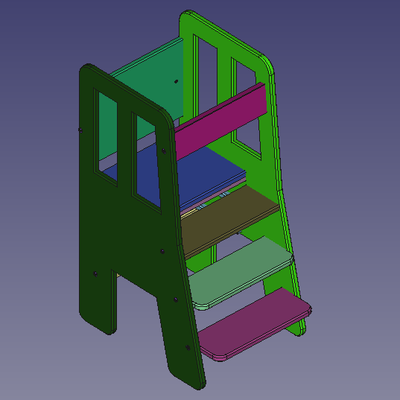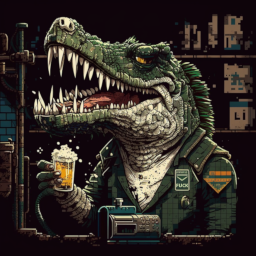I have pieces from an old chess game that I played a lot during my adolescence and so I have a special affection for it.
This game is missing some pieces that unfortunately have been lost over the years. I don’t have 3D modeling skills and I would like to know if there is any way or service for me to recreate these lost parts to be printed on a 3D printer.
All help is welcome and thank you all!
If you have at least one of each piece remaining, then yep - it’s easy!
The technology you’re after is called photogrammetry, and there are two inexpensive ways that I use often (there are more, but these are the two I rely on)
-
KIRI Engine - I have a subscription, but I think there is a free tier. You take about twenty photos of the object from different angles, upload for processing, and you get a 3D model back that you can print.
-
TRELLIS - take a single photograph and upload to here:
https://huggingface.co/spaces/JeffreyXiang/TRELLIS
You will receive a 3D model back that you can import into Blender, run a mesh operation to merge by distance (to create a watertight model), export as STL and then print.
KIRI Engine requires more work upfront, with all the photos, but is the best at recreating existing things accurately.
TRELLIS requires more work at the end, because it doesn’t automatically create printable models, and it isn’t a finished product yet, but it is the closest thing to actual witchcraft I’ve experienced.
Wow. Trellis is kind of neat! You can throw the glb into imagetostl.com and it will spit out a very usable stl quickly.
I didn’t know imagetostl took glbs! I honestly wouldn’t even have expected it!
I’ll definitely be using that then. Blender is great, but I’m tied to one machine - I’d much rather use online tools when I can.
Thanks for that :)
This template looks very interesting too, I’ll take a look at it
-
Unless they are all unique, you should be able to make a silicone mold of a remaining piece to duplicate in resin/plaster/etc.
Look up resin casting resources for more how-to (posting from work, so cannot dig them up).
Don’t take this the wrong way but, what skills do you have?
If you’re a maker type there are some raspberry pi based 3d scanners that might be a good start.
https://openscan-org.github.io/OpenScan-Doc/
Looks like it’s less dead than some of the others.
Or there are commercial options.
wow nice project I’m reading the documentation
Thanks for sharing!
Numchuck skills, bow-hunting skills, and computer hacking skills. Will those suffice?
I think the computer hacking will be the most useful for this project.
deleted by creator
Look into photogrammetry. You basically take pictures of the object from different angles and use software to spit out a 3D model. It works best if you have the camera at a fixed length from the object, and just rotate the object in place. There are a few apps out there that will do it
No better time than the present to learn a new skill! Especially with the amount of resources available nowadays.
Personally I’d take picture of each piece from at least 3 sides (top, left, front) all with an object of known size (like a ruler) in frame. Then pick your software (Blender is AWESOME) and faff about and stumble through and learn.
It’s hard at first but the level of satisfaction that comes from learning a new skill is immense.
@chemicalwonka The #FreeCAD community might be willing to help. Please create a thread at the forum: https://forum.freecad.org/
I will research about some suggestions I received here but thank you for your suggestion too, it’s noted
You got a lot of replies on the modeling side of things. It’s not clear if you have a printer, so let me quickly hit on that.
There are a bunch of different 3D printing services you can use to print things, including local (at your library potentially or a maker space) as well as commercial.
3D printera fall into big buckets:
- melt the material as you go. The most common version is FDM. FDM printers can make somewhat fine detailed prints, but their forte is making larger things with larger details
- deposit a layer of material and fuse it via light. This can be done with a powered material and a laser (SLS) or a liquid resin and a light source (SLA). This method produces much higher detailed prints, but has a bigger barrier to entry. SLS printers are expensive, but can produce large and very durable prints. SLA printers have affordable home versions, but their build volume is somewhat small, their parts will require post processing to finish (rinsing, during), and you will have to deal with responsible disposal of the used resins and solvents. Resin prints are hard, but can be a bit brittle
If you’re going to be purchasing the prints, I would go SLS. You’ll get fine details and the parts can be nylon (or even metal) so they’ll be durable.
If you’re printing at home, SLA is probably the way to go.
I don’t have any specific recommendations for software or services, but I do have a couple general thoughts on this problem
How many pieces are missing and how ornate is the set?
If you have at least one of every piece the easiest course of action is probably to 3d scan them. A scanner is probably a bit pricey to buy just for this one project, but if you ask around you can probably find a hobbyist or makerspace that will let you use theirs.
If you can’t find a scanner, as long as your set isn’t too ornate, most chest sets are probably pretty easy to model for the most part. Except for the knights which are of course horses which are a weird irregular shape, most chess pieces are essentially cylinders and cones of various sizes stacked on top of each other. With a little quality time taking measurements with some calipers and some youtube how-to videos, you could probably learn enough to make a pretty decent model pretty quickly.
You might even be able to carefully trace your pieces onto a piece of paper or maybe use a contour gauge to do the same, scan that tracing into your computer, and create a 3d model from that profile. Heck, you might even be able to just take a picture of the pieces then trace them on your computer.
It’s been a long time since I’ve done any 3d modeling personally, but something like that is a feature in a lot of software I’ve used.
Then you’d just need to add some details- a slot cut into the bishops hat, some crenulations at the top of the rook, a cross on top of the king, etc. which should all also be pretty straightforward to model
Again, if you ask around at makerspaces and such you can probably find someone willing to take up the challenge or help you figure out how to do that.
Of course if your set has a lot of textures and details you wouldn’t be able to capture them that way, like if your pieces have a face or otherwise aren’t rotationally symmetrical, or the rook has a brick pattern, etc.
And if you need to model the knight, that’s going to take some more advanced modeling skills unless it’s a really simple and kind of abstract horse.
If you are missing pieces entirely, unless you can track down another set to use as a reference, you’re going to have to recreate them from scratch. You can take some styling cues from the other pieces- like the bases are probably all pretty much the same, but beyond that you’d kind of have to work off of memory and eyeballing them.
EDIT: When all you have is a hammer, everything looks like a nail. I was thinking about good ways to recreate your missing pieces by 3D printing so I kind of forgot to consider other techniques
Again, assuming you have at least one of each of the pieces you need, make a mold and cast new ones out of epoxy or something.
Also, again assuming no detailed textures, except for the knights, most chess pieces are almost perfect lathe projects. There’s some really cheap tiny lathes to be had on Amazon that would probably be up to the task of turning a chunk of plastic into a chess piece.
If u have another piece of the right shape u can copy them with one of those 3d scanner apps that use ur phone camera
yes I have
Does these apps creates a reliable good enough models to print?
Can you reccomend an app?
They might need a little cleanup but u should be able to learn those skills relatively easily. I can’t remember any specific name have a google and try some.
While Bambu Lab does have a bad reputation, I have made surprisingly good experiences with their AI Scanner tool and would recommend it.
Ok then, downvote me I guess. ¯\_(ツ)_/¯





